Analyzing the Darfur Conflict: Reasons, Theories, and Global Response
VerifiedAdded on 2023/06/15
|19
|6216
|254
Essay
AI Summary
This essay provides an in-depth analysis of the Darfur conflict, exploring the underlying reasons beyond ethnic hatred, such as the use of the Janjaweed militia and environmental threats. It examines the conflict through the lens of international relations theories, including structural realism, liberal internationalism, and constructivism, to understand the global engagement in the crisis. The essay also discusses the international response to the conflict, including UN peacekeeping missions, EU involvement, and the role of NGOs and advocacy groups. It highlights the challenges in achieving peace and the impact of international pressure on the peace negotiations, emphasizing the need for a broader understanding of the complex issues affecting the region. Desklib offers students access to this essay and many other resources to aid in their studies.
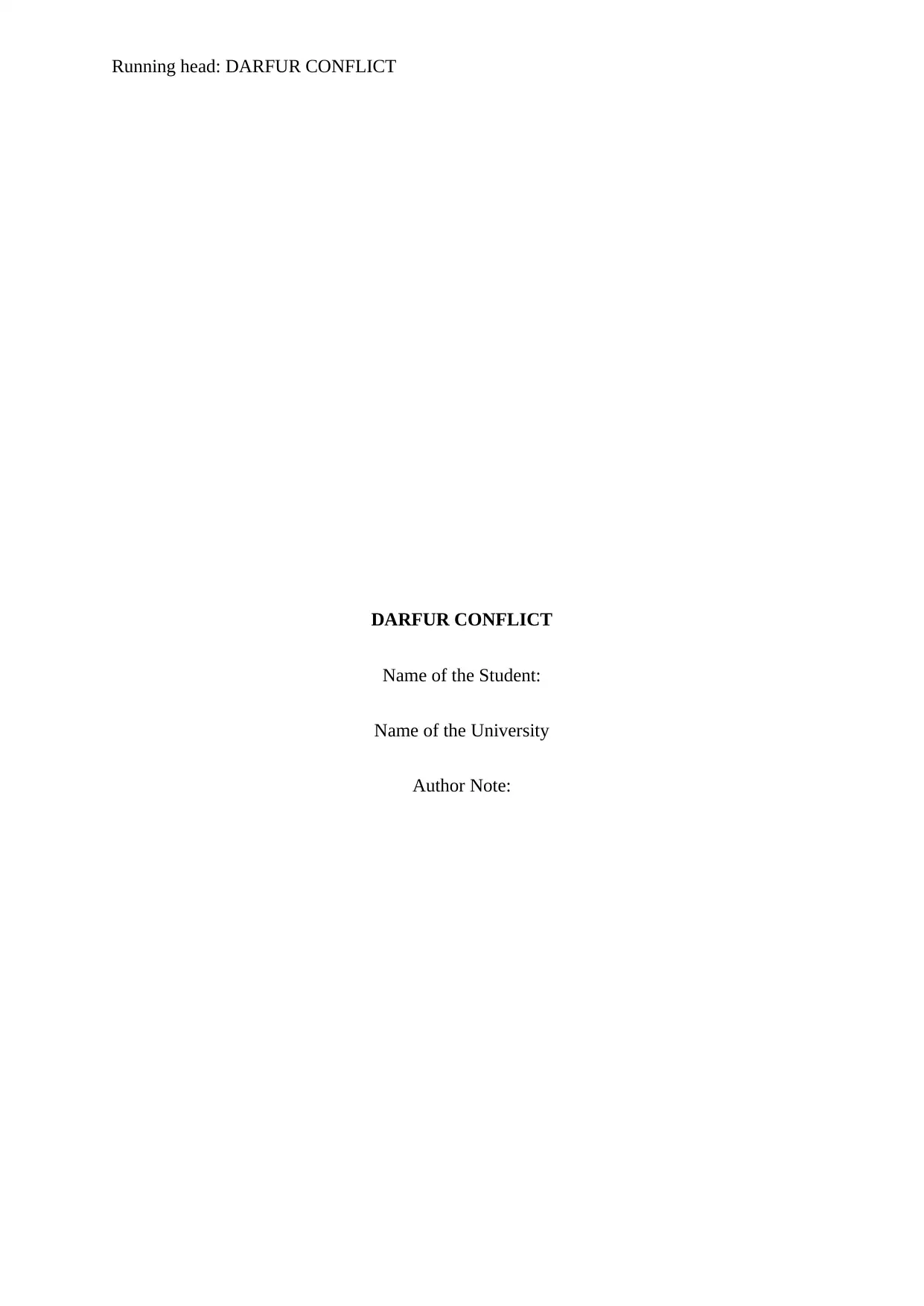
Running head: DARFUR CONFLICT
DARFUR CONFLICT
Name of the Student:
Name of the University
Author Note:
DARFUR CONFLICT
Name of the Student:
Name of the University
Author Note:
Paraphrase This Document
Need a fresh take? Get an instant paraphrase of this document with our AI Paraphraser
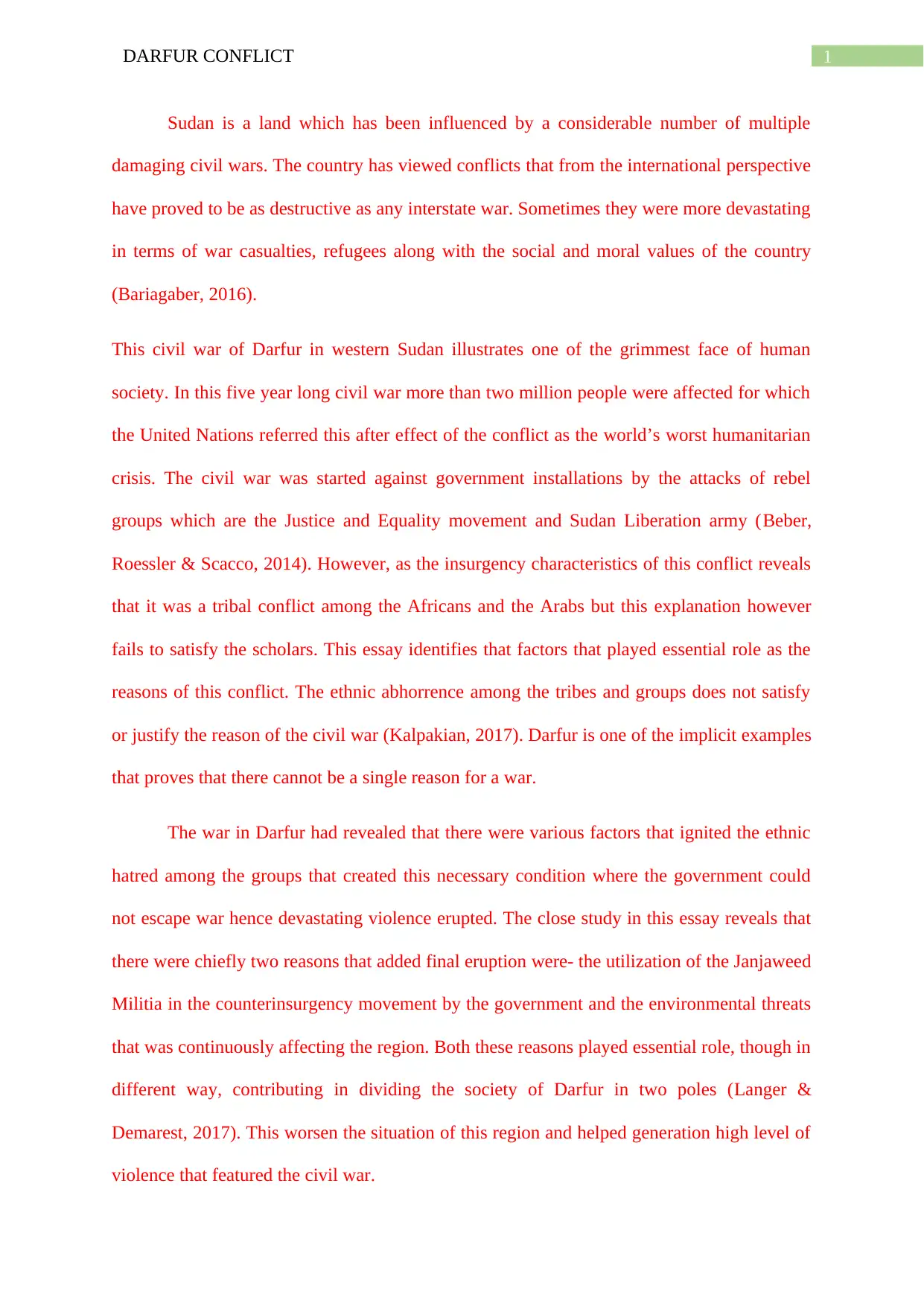
1DARFUR CONFLICT
Sudan is a land which has been influenced by a considerable number of multiple
damaging civil wars. The country has viewed conflicts that from the international perspective
have proved to be as destructive as any interstate war. Sometimes they were more devastating
in terms of war casualties, refugees along with the social and moral values of the country
(Bariagaber, 2016).
This civil war of Darfur in western Sudan illustrates one of the grimmest face of human
society. In this five year long civil war more than two million people were affected for which
the United Nations referred this after effect of the conflict as the world’s worst humanitarian
crisis. The civil war was started against government installations by the attacks of rebel
groups which are the Justice and Equality movement and Sudan Liberation army (Beber,
Roessler & Scacco, 2014). However, as the insurgency characteristics of this conflict reveals
that it was a tribal conflict among the Africans and the Arabs but this explanation however
fails to satisfy the scholars. This essay identifies that factors that played essential role as the
reasons of this conflict. The ethnic abhorrence among the tribes and groups does not satisfy
or justify the reason of the civil war (Kalpakian, 2017). Darfur is one of the implicit examples
that proves that there cannot be a single reason for a war.
The war in Darfur had revealed that there were various factors that ignited the ethnic
hatred among the groups that created this necessary condition where the government could
not escape war hence devastating violence erupted. The close study in this essay reveals that
there were chiefly two reasons that added final eruption were- the utilization of the Janjaweed
Militia in the counterinsurgency movement by the government and the environmental threats
that was continuously affecting the region. Both these reasons played essential role, though in
different way, contributing in dividing the society of Darfur in two poles (Langer &
Demarest, 2017). This worsen the situation of this region and helped generation high level of
violence that featured the civil war.
Sudan is a land which has been influenced by a considerable number of multiple
damaging civil wars. The country has viewed conflicts that from the international perspective
have proved to be as destructive as any interstate war. Sometimes they were more devastating
in terms of war casualties, refugees along with the social and moral values of the country
(Bariagaber, 2016).
This civil war of Darfur in western Sudan illustrates one of the grimmest face of human
society. In this five year long civil war more than two million people were affected for which
the United Nations referred this after effect of the conflict as the world’s worst humanitarian
crisis. The civil war was started against government installations by the attacks of rebel
groups which are the Justice and Equality movement and Sudan Liberation army (Beber,
Roessler & Scacco, 2014). However, as the insurgency characteristics of this conflict reveals
that it was a tribal conflict among the Africans and the Arabs but this explanation however
fails to satisfy the scholars. This essay identifies that factors that played essential role as the
reasons of this conflict. The ethnic abhorrence among the tribes and groups does not satisfy
or justify the reason of the civil war (Kalpakian, 2017). Darfur is one of the implicit examples
that proves that there cannot be a single reason for a war.
The war in Darfur had revealed that there were various factors that ignited the ethnic
hatred among the groups that created this necessary condition where the government could
not escape war hence devastating violence erupted. The close study in this essay reveals that
there were chiefly two reasons that added final eruption were- the utilization of the Janjaweed
Militia in the counterinsurgency movement by the government and the environmental threats
that was continuously affecting the region. Both these reasons played essential role, though in
different way, contributing in dividing the society of Darfur in two poles (Langer &
Demarest, 2017). This worsen the situation of this region and helped generation high level of
violence that featured the civil war.
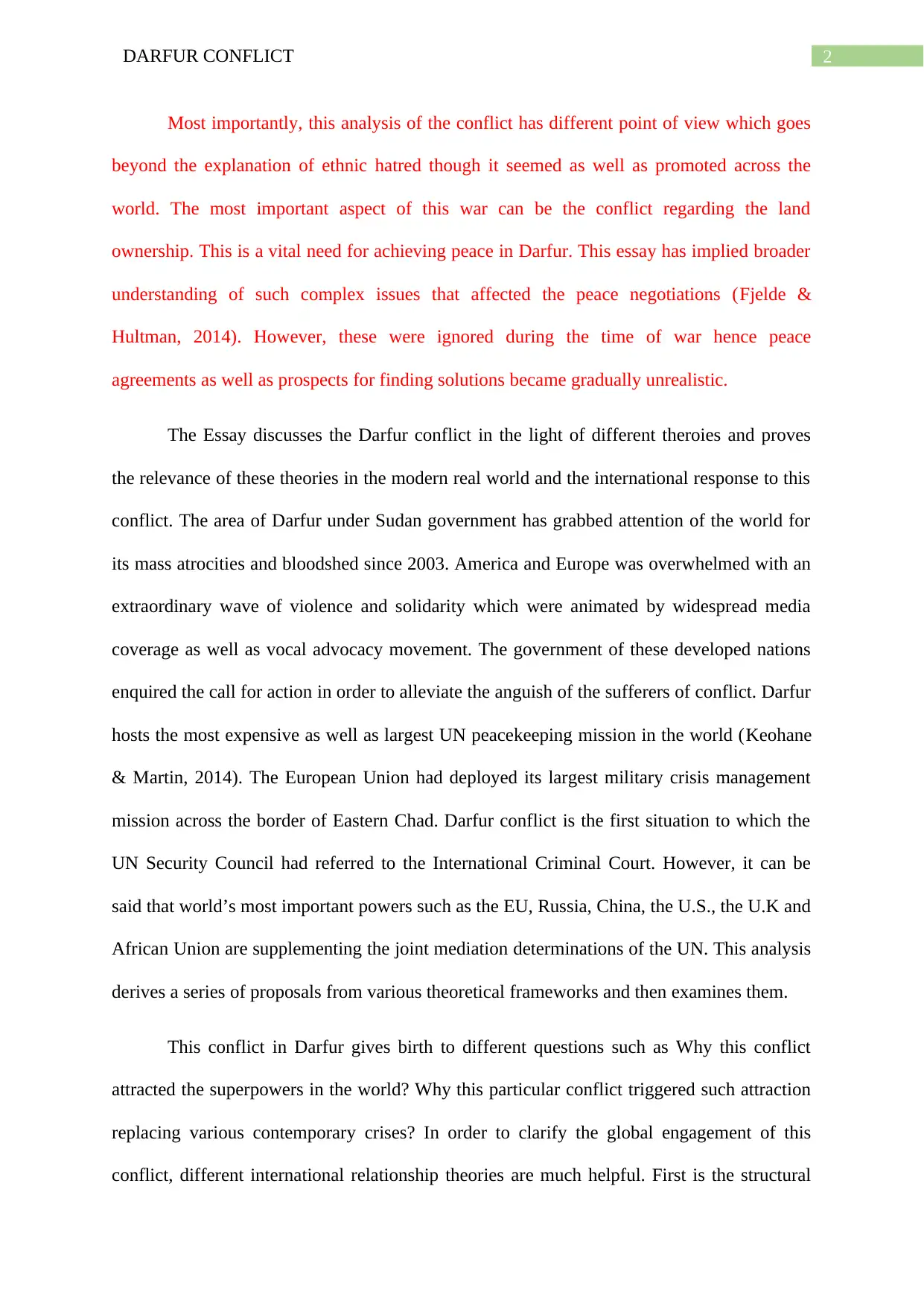
2DARFUR CONFLICT
Most importantly, this analysis of the conflict has different point of view which goes
beyond the explanation of ethnic hatred though it seemed as well as promoted across the
world. The most important aspect of this war can be the conflict regarding the land
ownership. This is a vital need for achieving peace in Darfur. This essay has implied broader
understanding of such complex issues that affected the peace negotiations (Fjelde &
Hultman, 2014). However, these were ignored during the time of war hence peace
agreements as well as prospects for finding solutions became gradually unrealistic.
The Essay discusses the Darfur conflict in the light of different theroies and proves
the relevance of these theories in the modern real world and the international response to this
conflict. The area of Darfur under Sudan government has grabbed attention of the world for
its mass atrocities and bloodshed since 2003. America and Europe was overwhelmed with an
extraordinary wave of violence and solidarity which were animated by widespread media
coverage as well as vocal advocacy movement. The government of these developed nations
enquired the call for action in order to alleviate the anguish of the sufferers of conflict. Darfur
hosts the most expensive as well as largest UN peacekeeping mission in the world (Keohane
& Martin, 2014). The European Union had deployed its largest military crisis management
mission across the border of Eastern Chad. Darfur conflict is the first situation to which the
UN Security Council had referred to the International Criminal Court. However, it can be
said that world’s most important powers such as the EU, Russia, China, the U.S., the U.K and
African Union are supplementing the joint mediation determinations of the UN. This analysis
derives a series of proposals from various theoretical frameworks and then examines them.
This conflict in Darfur gives birth to different questions such as Why this conflict
attracted the superpowers in the world? Why this particular conflict triggered such attraction
replacing various contemporary crises? In order to clarify the global engagement of this
conflict, different international relationship theories are much helpful. First is the structural
Most importantly, this analysis of the conflict has different point of view which goes
beyond the explanation of ethnic hatred though it seemed as well as promoted across the
world. The most important aspect of this war can be the conflict regarding the land
ownership. This is a vital need for achieving peace in Darfur. This essay has implied broader
understanding of such complex issues that affected the peace negotiations (Fjelde &
Hultman, 2014). However, these were ignored during the time of war hence peace
agreements as well as prospects for finding solutions became gradually unrealistic.
The Essay discusses the Darfur conflict in the light of different theroies and proves
the relevance of these theories in the modern real world and the international response to this
conflict. The area of Darfur under Sudan government has grabbed attention of the world for
its mass atrocities and bloodshed since 2003. America and Europe was overwhelmed with an
extraordinary wave of violence and solidarity which were animated by widespread media
coverage as well as vocal advocacy movement. The government of these developed nations
enquired the call for action in order to alleviate the anguish of the sufferers of conflict. Darfur
hosts the most expensive as well as largest UN peacekeeping mission in the world (Keohane
& Martin, 2014). The European Union had deployed its largest military crisis management
mission across the border of Eastern Chad. Darfur conflict is the first situation to which the
UN Security Council had referred to the International Criminal Court. However, it can be
said that world’s most important powers such as the EU, Russia, China, the U.S., the U.K and
African Union are supplementing the joint mediation determinations of the UN. This analysis
derives a series of proposals from various theoretical frameworks and then examines them.
This conflict in Darfur gives birth to different questions such as Why this conflict
attracted the superpowers in the world? Why this particular conflict triggered such attraction
replacing various contemporary crises? In order to clarify the global engagement of this
conflict, different international relationship theories are much helpful. First is the structural
⊘ This is a preview!⊘
Do you want full access?
Subscribe today to unlock all pages.

Trusted by 1+ million students worldwide
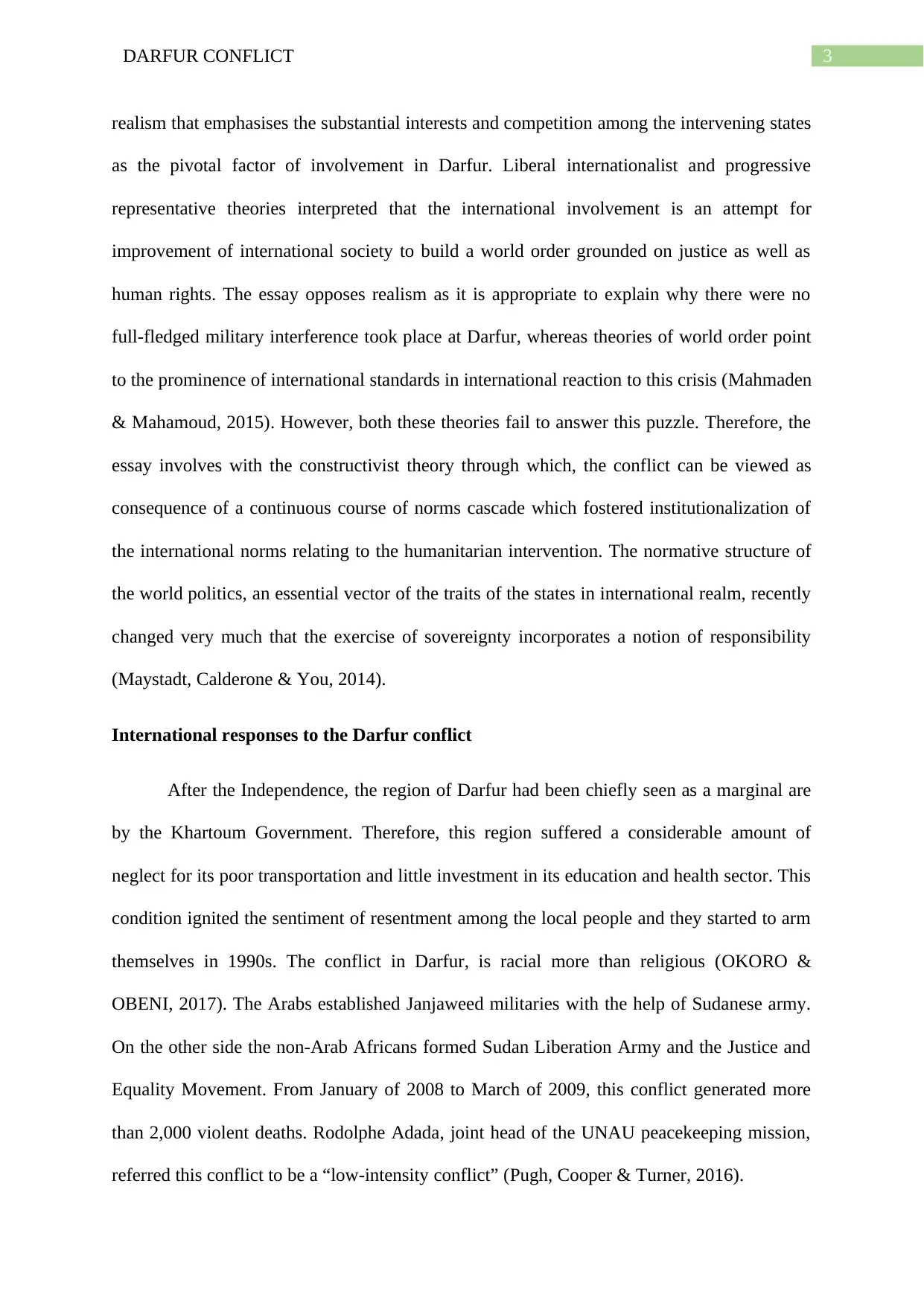
3DARFUR CONFLICT
realism that emphasises the substantial interests and competition among the intervening states
as the pivotal factor of involvement in Darfur. Liberal internationalist and progressive
representative theories interpreted that the international involvement is an attempt for
improvement of international society to build a world order grounded on justice as well as
human rights. The essay opposes realism as it is appropriate to explain why there were no
full-fledged military interference took place at Darfur, whereas theories of world order point
to the prominence of international standards in international reaction to this crisis (Mahmaden
& Mahamoud, 2015). However, both these theories fail to answer this puzzle. Therefore, the
essay involves with the constructivist theory through which, the conflict can be viewed as
consequence of a continuous course of norms cascade which fostered institutionalization of
the international norms relating to the humanitarian intervention. The normative structure of
the world politics, an essential vector of the traits of the states in international realm, recently
changed very much that the exercise of sovereignty incorporates a notion of responsibility
(Maystadt, Calderone & You, 2014).
International responses to the Darfur conflict
After the Independence, the region of Darfur had been chiefly seen as a marginal are
by the Khartoum Government. Therefore, this region suffered a considerable amount of
neglect for its poor transportation and little investment in its education and health sector. This
condition ignited the sentiment of resentment among the local people and they started to arm
themselves in 1990s. The conflict in Darfur, is racial more than religious (OKORO &
OBENI, 2017). The Arabs established Janjaweed militaries with the help of Sudanese army.
On the other side the non-Arab Africans formed Sudan Liberation Army and the Justice and
Equality Movement. From January of 2008 to March of 2009, this conflict generated more
than 2,000 violent deaths. Rodolphe Adada, joint head of the UNAU peacekeeping mission,
referred this conflict to be a “low-intensity conflict” (Pugh, Cooper & Turner, 2016).
realism that emphasises the substantial interests and competition among the intervening states
as the pivotal factor of involvement in Darfur. Liberal internationalist and progressive
representative theories interpreted that the international involvement is an attempt for
improvement of international society to build a world order grounded on justice as well as
human rights. The essay opposes realism as it is appropriate to explain why there were no
full-fledged military interference took place at Darfur, whereas theories of world order point
to the prominence of international standards in international reaction to this crisis (Mahmaden
& Mahamoud, 2015). However, both these theories fail to answer this puzzle. Therefore, the
essay involves with the constructivist theory through which, the conflict can be viewed as
consequence of a continuous course of norms cascade which fostered institutionalization of
the international norms relating to the humanitarian intervention. The normative structure of
the world politics, an essential vector of the traits of the states in international realm, recently
changed very much that the exercise of sovereignty incorporates a notion of responsibility
(Maystadt, Calderone & You, 2014).
International responses to the Darfur conflict
After the Independence, the region of Darfur had been chiefly seen as a marginal are
by the Khartoum Government. Therefore, this region suffered a considerable amount of
neglect for its poor transportation and little investment in its education and health sector. This
condition ignited the sentiment of resentment among the local people and they started to arm
themselves in 1990s. The conflict in Darfur, is racial more than religious (OKORO &
OBENI, 2017). The Arabs established Janjaweed militaries with the help of Sudanese army.
On the other side the non-Arab Africans formed Sudan Liberation Army and the Justice and
Equality Movement. From January of 2008 to March of 2009, this conflict generated more
than 2,000 violent deaths. Rodolphe Adada, joint head of the UNAU peacekeeping mission,
referred this conflict to be a “low-intensity conflict” (Pugh, Cooper & Turner, 2016).
Paraphrase This Document
Need a fresh take? Get an instant paraphrase of this document with our AI Paraphraser
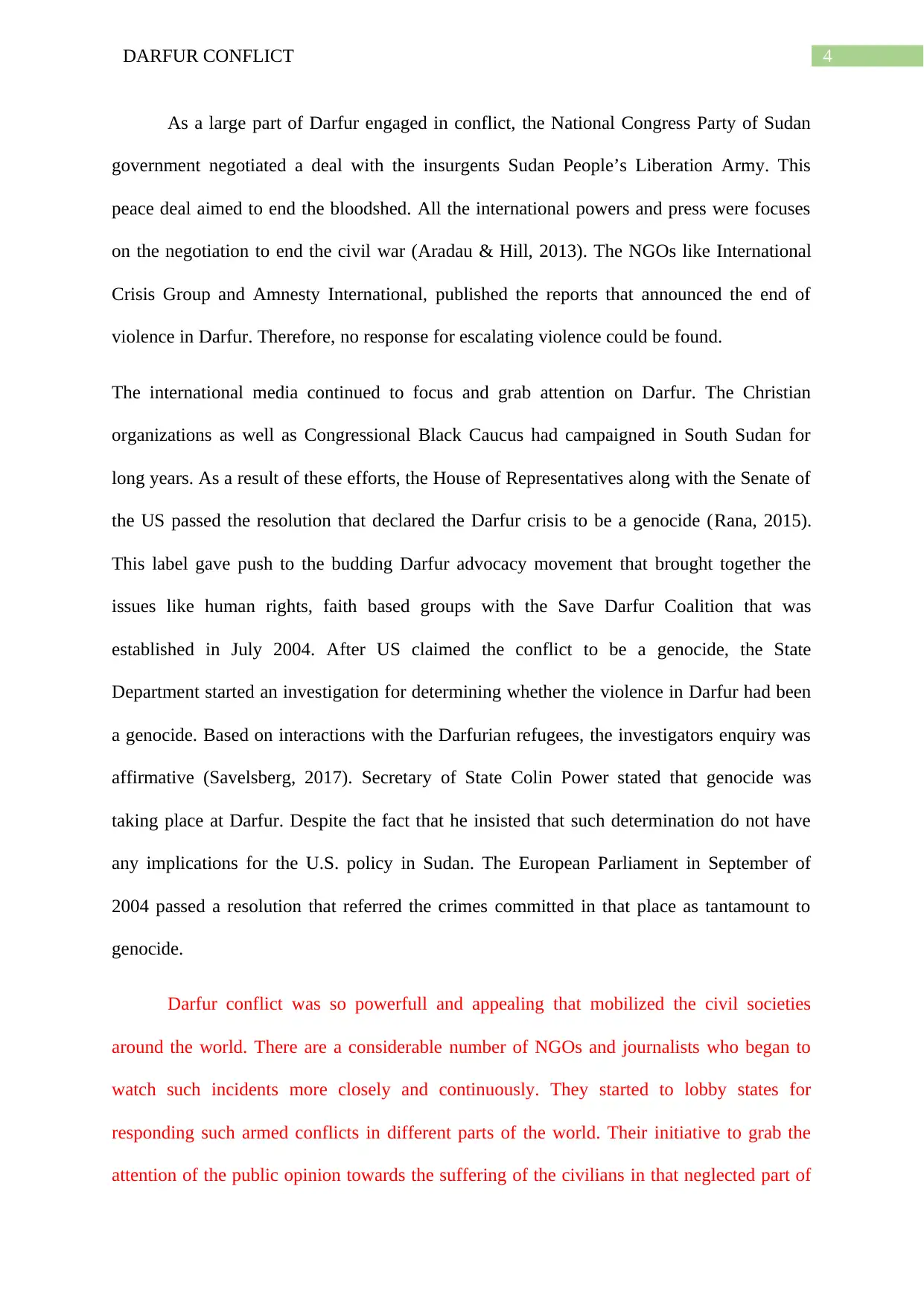
4DARFUR CONFLICT
As a large part of Darfur engaged in conflict, the National Congress Party of Sudan
government negotiated a deal with the insurgents Sudan People’s Liberation Army. This
peace deal aimed to end the bloodshed. All the international powers and press were focuses
on the negotiation to end the civil war (Aradau & Hill, 2013). The NGOs like International
Crisis Group and Amnesty International, published the reports that announced the end of
violence in Darfur. Therefore, no response for escalating violence could be found.
The international media continued to focus and grab attention on Darfur. The Christian
organizations as well as Congressional Black Caucus had campaigned in South Sudan for
long years. As a result of these efforts, the House of Representatives along with the Senate of
the US passed the resolution that declared the Darfur crisis to be a genocide (Rana, 2015).
This label gave push to the budding Darfur advocacy movement that brought together the
issues like human rights, faith based groups with the Save Darfur Coalition that was
established in July 2004. After US claimed the conflict to be a genocide, the State
Department started an investigation for determining whether the violence in Darfur had been
a genocide. Based on interactions with the Darfurian refugees, the investigators enquiry was
affirmative (Savelsberg, 2017). Secretary of State Colin Power stated that genocide was
taking place at Darfur. Despite the fact that he insisted that such determination do not have
any implications for the U.S. policy in Sudan. The European Parliament in September of
2004 passed a resolution that referred the crimes committed in that place as tantamount to
genocide.
Darfur conflict was so powerfull and appealing that mobilized the civil societies
around the world. There are a considerable number of NGOs and journalists who began to
watch such incidents more closely and continuously. They started to lobby states for
responding such armed conflicts in different parts of the world. Their initiative to grab the
attention of the public opinion towards the suffering of the civilians in that neglected part of
As a large part of Darfur engaged in conflict, the National Congress Party of Sudan
government negotiated a deal with the insurgents Sudan People’s Liberation Army. This
peace deal aimed to end the bloodshed. All the international powers and press were focuses
on the negotiation to end the civil war (Aradau & Hill, 2013). The NGOs like International
Crisis Group and Amnesty International, published the reports that announced the end of
violence in Darfur. Therefore, no response for escalating violence could be found.
The international media continued to focus and grab attention on Darfur. The Christian
organizations as well as Congressional Black Caucus had campaigned in South Sudan for
long years. As a result of these efforts, the House of Representatives along with the Senate of
the US passed the resolution that declared the Darfur crisis to be a genocide (Rana, 2015).
This label gave push to the budding Darfur advocacy movement that brought together the
issues like human rights, faith based groups with the Save Darfur Coalition that was
established in July 2004. After US claimed the conflict to be a genocide, the State
Department started an investigation for determining whether the violence in Darfur had been
a genocide. Based on interactions with the Darfurian refugees, the investigators enquiry was
affirmative (Savelsberg, 2017). Secretary of State Colin Power stated that genocide was
taking place at Darfur. Despite the fact that he insisted that such determination do not have
any implications for the U.S. policy in Sudan. The European Parliament in September of
2004 passed a resolution that referred the crimes committed in that place as tantamount to
genocide.
Darfur conflict was so powerfull and appealing that mobilized the civil societies
around the world. There are a considerable number of NGOs and journalists who began to
watch such incidents more closely and continuously. They started to lobby states for
responding such armed conflicts in different parts of the world. Their initiative to grab the
attention of the public opinion towards the suffering of the civilians in that neglected part of
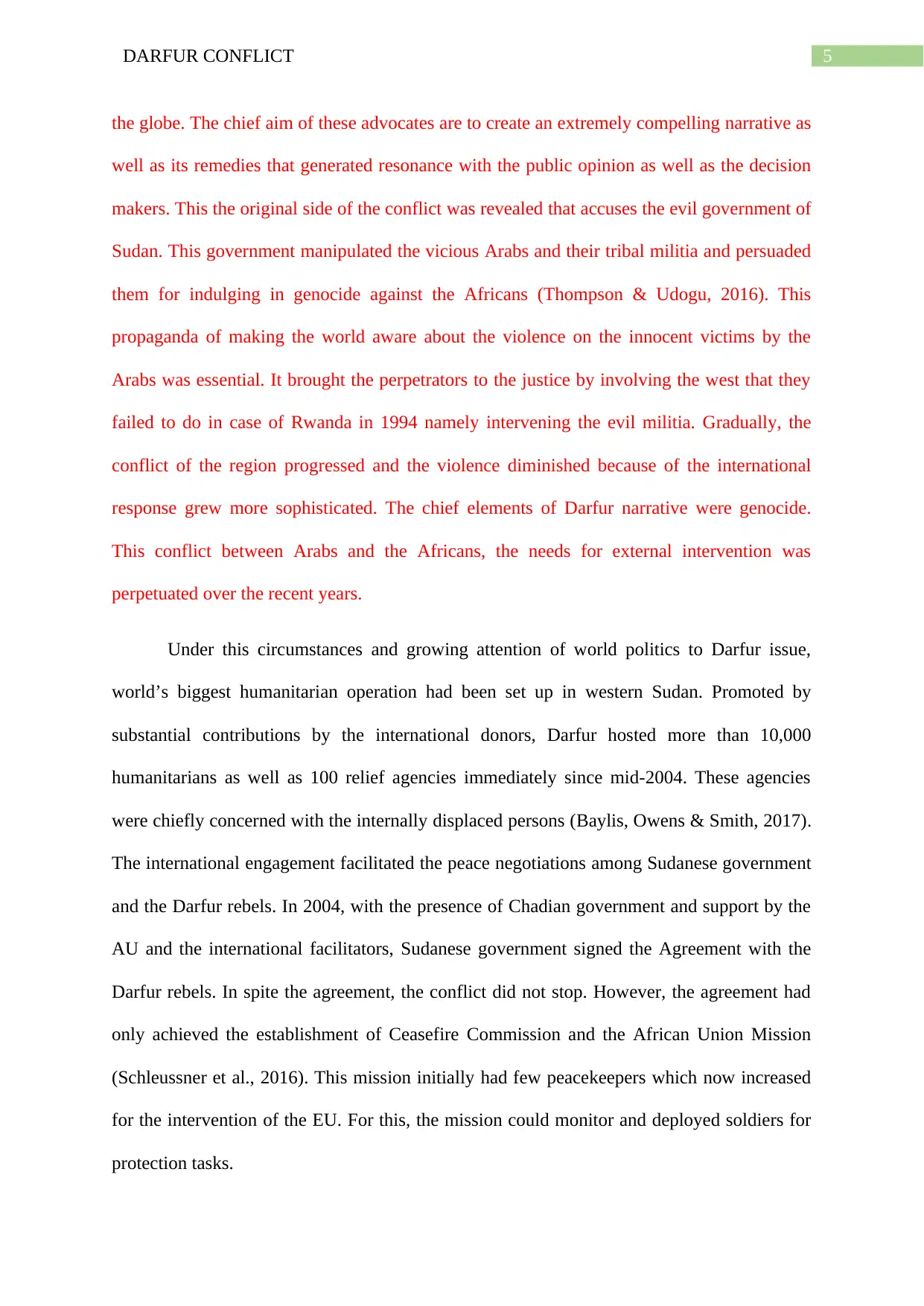
5DARFUR CONFLICT
the globe. The chief aim of these advocates are to create an extremely compelling narrative as
well as its remedies that generated resonance with the public opinion as well as the decision
makers. This the original side of the conflict was revealed that accuses the evil government of
Sudan. This government manipulated the vicious Arabs and their tribal militia and persuaded
them for indulging in genocide against the Africans (Thompson & Udogu, 2016). This
propaganda of making the world aware about the violence on the innocent victims by the
Arabs was essential. It brought the perpetrators to the justice by involving the west that they
failed to do in case of Rwanda in 1994 namely intervening the evil militia. Gradually, the
conflict of the region progressed and the violence diminished because of the international
response grew more sophisticated. The chief elements of Darfur narrative were genocide.
This conflict between Arabs and the Africans, the needs for external intervention was
perpetuated over the recent years.
Under this circumstances and growing attention of world politics to Darfur issue,
world’s biggest humanitarian operation had been set up in western Sudan. Promoted by
substantial contributions by the international donors, Darfur hosted more than 10,000
humanitarians as well as 100 relief agencies immediately since mid-2004. These agencies
were chiefly concerned with the internally displaced persons (Baylis, Owens & Smith, 2017).
The international engagement facilitated the peace negotiations among Sudanese government
and the Darfur rebels. In 2004, with the presence of Chadian government and support by the
AU and the international facilitators, Sudanese government signed the Agreement with the
Darfur rebels. In spite the agreement, the conflict did not stop. However, the agreement had
only achieved the establishment of Ceasefire Commission and the African Union Mission
(Schleussner et al., 2016). This mission initially had few peacekeepers which now increased
for the intervention of the EU. For this, the mission could monitor and deployed soldiers for
protection tasks.
the globe. The chief aim of these advocates are to create an extremely compelling narrative as
well as its remedies that generated resonance with the public opinion as well as the decision
makers. This the original side of the conflict was revealed that accuses the evil government of
Sudan. This government manipulated the vicious Arabs and their tribal militia and persuaded
them for indulging in genocide against the Africans (Thompson & Udogu, 2016). This
propaganda of making the world aware about the violence on the innocent victims by the
Arabs was essential. It brought the perpetrators to the justice by involving the west that they
failed to do in case of Rwanda in 1994 namely intervening the evil militia. Gradually, the
conflict of the region progressed and the violence diminished because of the international
response grew more sophisticated. The chief elements of Darfur narrative were genocide.
This conflict between Arabs and the Africans, the needs for external intervention was
perpetuated over the recent years.
Under this circumstances and growing attention of world politics to Darfur issue,
world’s biggest humanitarian operation had been set up in western Sudan. Promoted by
substantial contributions by the international donors, Darfur hosted more than 10,000
humanitarians as well as 100 relief agencies immediately since mid-2004. These agencies
were chiefly concerned with the internally displaced persons (Baylis, Owens & Smith, 2017).
The international engagement facilitated the peace negotiations among Sudanese government
and the Darfur rebels. In 2004, with the presence of Chadian government and support by the
AU and the international facilitators, Sudanese government signed the Agreement with the
Darfur rebels. In spite the agreement, the conflict did not stop. However, the agreement had
only achieved the establishment of Ceasefire Commission and the African Union Mission
(Schleussner et al., 2016). This mission initially had few peacekeepers which now increased
for the intervention of the EU. For this, the mission could monitor and deployed soldiers for
protection tasks.
⊘ This is a preview!⊘
Do you want full access?
Subscribe today to unlock all pages.

Trusted by 1+ million students worldwide
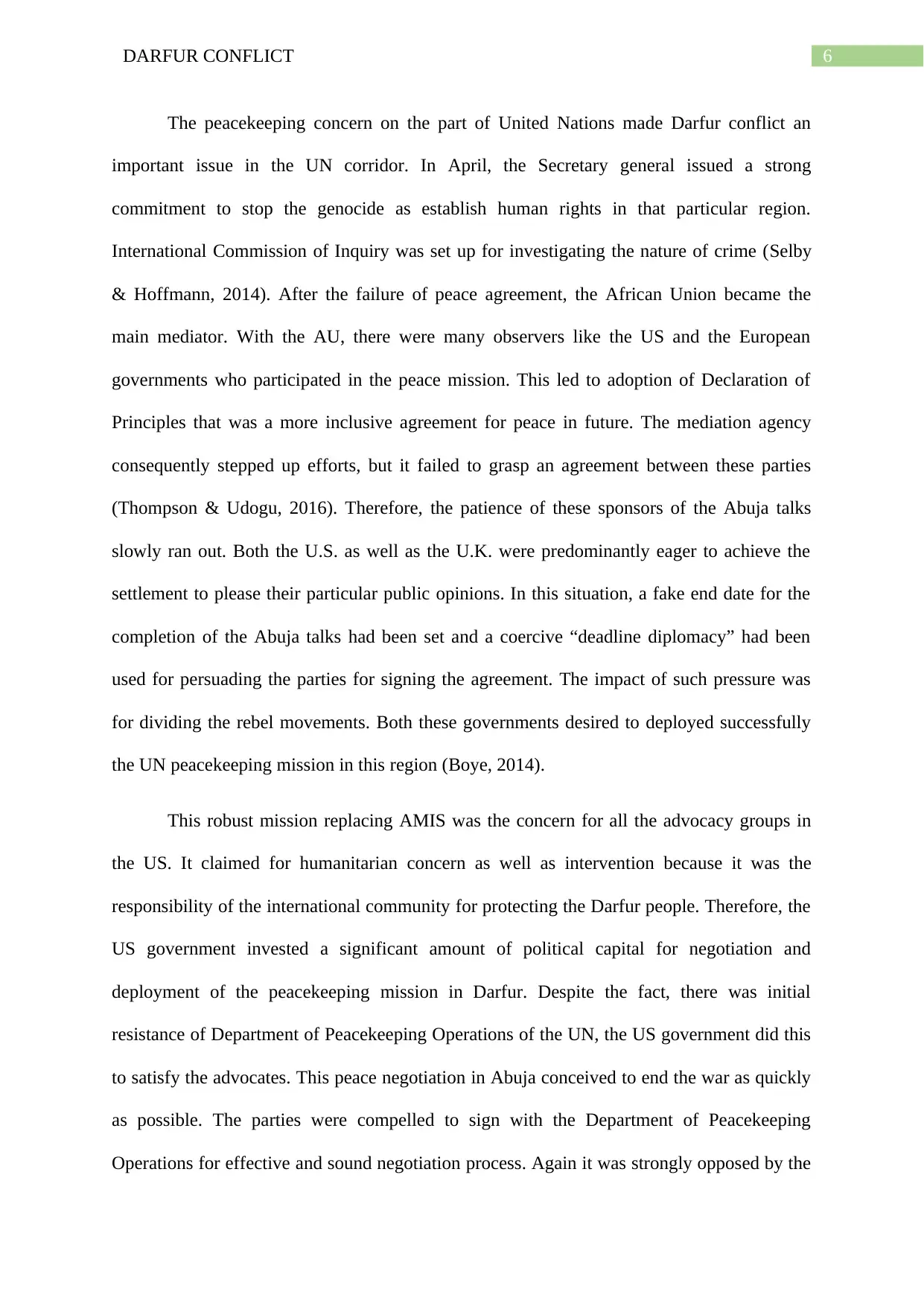
6DARFUR CONFLICT
The peacekeeping concern on the part of United Nations made Darfur conflict an
important issue in the UN corridor. In April, the Secretary general issued a strong
commitment to stop the genocide as establish human rights in that particular region.
International Commission of Inquiry was set up for investigating the nature of crime (Selby
& Hoffmann, 2014). After the failure of peace agreement, the African Union became the
main mediator. With the AU, there were many observers like the US and the European
governments who participated in the peace mission. This led to adoption of Declaration of
Principles that was a more inclusive agreement for peace in future. The mediation agency
consequently stepped up efforts, but it failed to grasp an agreement between these parties
(Thompson & Udogu, 2016). Therefore, the patience of these sponsors of the Abuja talks
slowly ran out. Both the U.S. as well as the U.K. were predominantly eager to achieve the
settlement to please their particular public opinions. In this situation, a fake end date for the
completion of the Abuja talks had been set and a coercive “deadline diplomacy” had been
used for persuading the parties for signing the agreement. The impact of such pressure was
for dividing the rebel movements. Both these governments desired to deployed successfully
the UN peacekeeping mission in this region (Boye, 2014).
This robust mission replacing AMIS was the concern for all the advocacy groups in
the US. It claimed for humanitarian concern as well as intervention because it was the
responsibility of the international community for protecting the Darfur people. Therefore, the
US government invested a significant amount of political capital for negotiation and
deployment of the peacekeeping mission in Darfur. Despite the fact, there was initial
resistance of Department of Peacekeeping Operations of the UN, the US government did this
to satisfy the advocates. This peace negotiation in Abuja conceived to end the war as quickly
as possible. The parties were compelled to sign with the Department of Peacekeeping
Operations for effective and sound negotiation process. Again it was strongly opposed by the
The peacekeeping concern on the part of United Nations made Darfur conflict an
important issue in the UN corridor. In April, the Secretary general issued a strong
commitment to stop the genocide as establish human rights in that particular region.
International Commission of Inquiry was set up for investigating the nature of crime (Selby
& Hoffmann, 2014). After the failure of peace agreement, the African Union became the
main mediator. With the AU, there were many observers like the US and the European
governments who participated in the peace mission. This led to adoption of Declaration of
Principles that was a more inclusive agreement for peace in future. The mediation agency
consequently stepped up efforts, but it failed to grasp an agreement between these parties
(Thompson & Udogu, 2016). Therefore, the patience of these sponsors of the Abuja talks
slowly ran out. Both the U.S. as well as the U.K. were predominantly eager to achieve the
settlement to please their particular public opinions. In this situation, a fake end date for the
completion of the Abuja talks had been set and a coercive “deadline diplomacy” had been
used for persuading the parties for signing the agreement. The impact of such pressure was
for dividing the rebel movements. Both these governments desired to deployed successfully
the UN peacekeeping mission in this region (Boye, 2014).
This robust mission replacing AMIS was the concern for all the advocacy groups in
the US. It claimed for humanitarian concern as well as intervention because it was the
responsibility of the international community for protecting the Darfur people. Therefore, the
US government invested a significant amount of political capital for negotiation and
deployment of the peacekeeping mission in Darfur. Despite the fact, there was initial
resistance of Department of Peacekeeping Operations of the UN, the US government did this
to satisfy the advocates. This peace negotiation in Abuja conceived to end the war as quickly
as possible. The parties were compelled to sign with the Department of Peacekeeping
Operations for effective and sound negotiation process. Again it was strongly opposed by the
Paraphrase This Document
Need a fresh take? Get an instant paraphrase of this document with our AI Paraphraser

7DARFUR CONFLICT
government of Sudan who portrayed the mission to be an imperial project for recolonising
Sudan (Behr & Kirke, 2017). In this case, Khartoum receive sufficient back up from China
and postponed the process of the agreement therefore, blocked the deployment of the
peacekeepers by taking another year of negotiation process. However, China later supported
the initiative of peacekeeping in Darfur.
The US government received strong support from the global superpowers for the
UNAMID. The student activists allied with the Save Darfur Coalition organized a positive
Sudan divestment campaign, similar to the anti-apartheid campaigns in South Africa. In spite
of playing vital role in peacekeeping mission in Darfur, the European nations were less active
than the US but the situation changed when Kouchner the foreign minister of France joined
hands in this operation. He was an advocate of the humanitarian intervention in Darfur from
the very beginning and was played active role in coordination of Urgence Darfur
(Cruikshank, 2014). Kouchner proposed for establishment of the peacekeeping force in the
eastern part of Chad and north-east Central African Republic with the aim to encompass the
war in Darfur across its border. Therefore, he convinced the EU for sponsoring the
peacekeeping mission to deploy force in this region.
With the involvement of world politics in the civil war of Darfur, the context of this
crisis changed drastically that led to diminishing violence. However, conflict among the
armed groups intensified where the signatory colleagues of the non-signatory rebel
movement associated with the Sudan government, attacked each other (Serneels &
Verpoorten, 2015). During this period, violence and attacks against the humanitarian
organizations vastly increased so as the inter-tribal clashes. In 2007 all the significant
resources as well as inclusive apaches of AU and UN failed. The biggest challenge became
managing the awkward coordination among the Arab countries which were gradually getting
involved peace process (De Waal et al., 2014). The situation got more complicated as the
government of Sudan who portrayed the mission to be an imperial project for recolonising
Sudan (Behr & Kirke, 2017). In this case, Khartoum receive sufficient back up from China
and postponed the process of the agreement therefore, blocked the deployment of the
peacekeepers by taking another year of negotiation process. However, China later supported
the initiative of peacekeeping in Darfur.
The US government received strong support from the global superpowers for the
UNAMID. The student activists allied with the Save Darfur Coalition organized a positive
Sudan divestment campaign, similar to the anti-apartheid campaigns in South Africa. In spite
of playing vital role in peacekeeping mission in Darfur, the European nations were less active
than the US but the situation changed when Kouchner the foreign minister of France joined
hands in this operation. He was an advocate of the humanitarian intervention in Darfur from
the very beginning and was played active role in coordination of Urgence Darfur
(Cruikshank, 2014). Kouchner proposed for establishment of the peacekeeping force in the
eastern part of Chad and north-east Central African Republic with the aim to encompass the
war in Darfur across its border. Therefore, he convinced the EU for sponsoring the
peacekeeping mission to deploy force in this region.
With the involvement of world politics in the civil war of Darfur, the context of this
crisis changed drastically that led to diminishing violence. However, conflict among the
armed groups intensified where the signatory colleagues of the non-signatory rebel
movement associated with the Sudan government, attacked each other (Serneels &
Verpoorten, 2015). During this period, violence and attacks against the humanitarian
organizations vastly increased so as the inter-tribal clashes. In 2007 all the significant
resources as well as inclusive apaches of AU and UN failed. The biggest challenge became
managing the awkward coordination among the Arab countries which were gradually getting
involved peace process (De Waal et al., 2014). The situation got more complicated as the
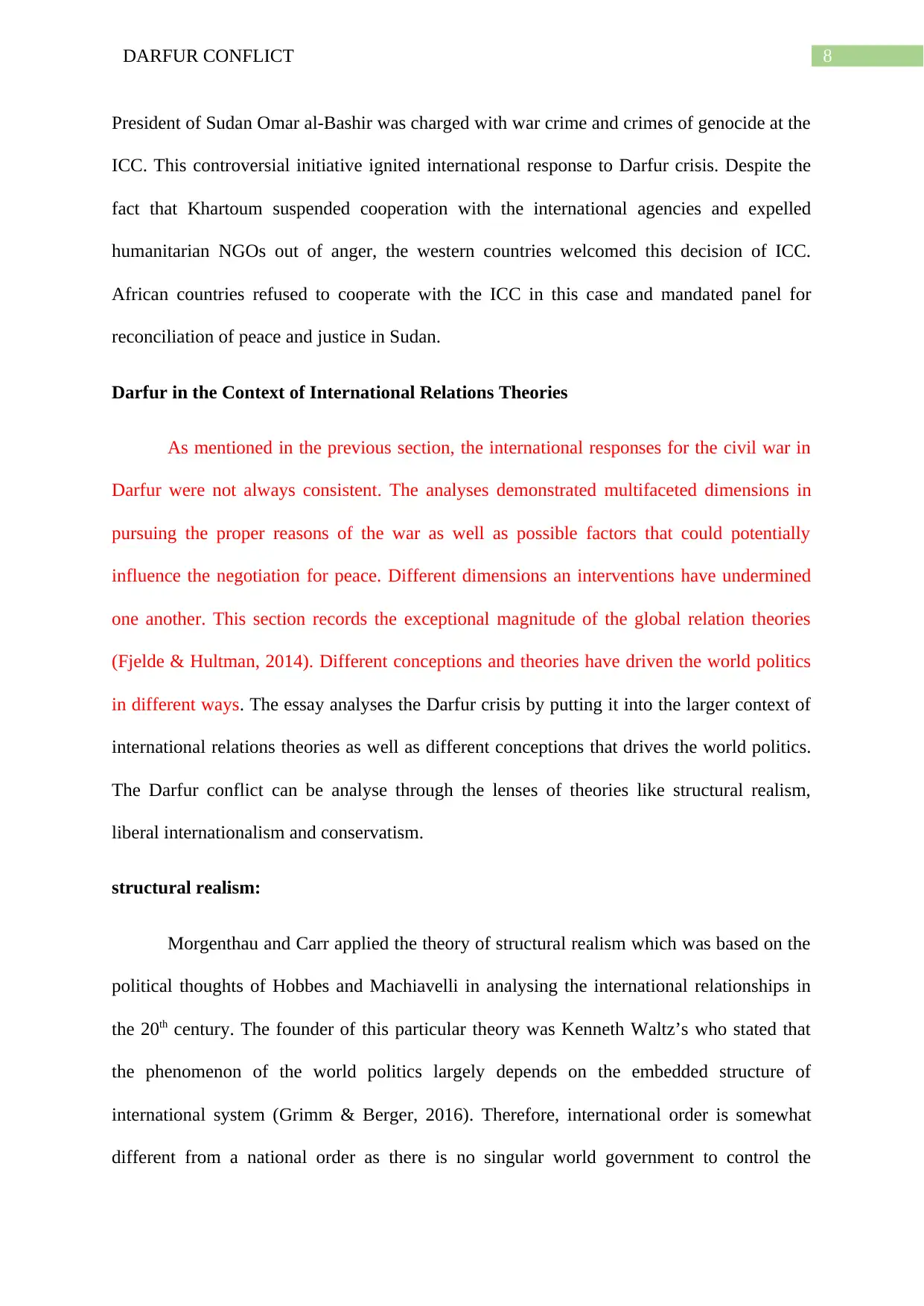
8DARFUR CONFLICT
President of Sudan Omar al-Bashir was charged with war crime and crimes of genocide at the
ICC. This controversial initiative ignited international response to Darfur crisis. Despite the
fact that Khartoum suspended cooperation with the international agencies and expelled
humanitarian NGOs out of anger, the western countries welcomed this decision of ICC.
African countries refused to cooperate with the ICC in this case and mandated panel for
reconciliation of peace and justice in Sudan.
Darfur in the Context of International Relations Theories
As mentioned in the previous section, the international responses for the civil war in
Darfur were not always consistent. The analyses demonstrated multifaceted dimensions in
pursuing the proper reasons of the war as well as possible factors that could potentially
influence the negotiation for peace. Different dimensions an interventions have undermined
one another. This section records the exceptional magnitude of the global relation theories
(Fjelde & Hultman, 2014). Different conceptions and theories have driven the world politics
in different ways. The essay analyses the Darfur crisis by putting it into the larger context of
international relations theories as well as different conceptions that drives the world politics.
The Darfur conflict can be analyse through the lenses of theories like structural realism,
liberal internationalism and conservatism.
structural realism:
Morgenthau and Carr applied the theory of structural realism which was based on the
political thoughts of Hobbes and Machiavelli in analysing the international relationships in
the 20th century. The founder of this particular theory was Kenneth Waltz’s who stated that
the phenomenon of the world politics largely depends on the embedded structure of
international system (Grimm & Berger, 2016). Therefore, international order is somewhat
different from a national order as there is no singular world government to control the
President of Sudan Omar al-Bashir was charged with war crime and crimes of genocide at the
ICC. This controversial initiative ignited international response to Darfur crisis. Despite the
fact that Khartoum suspended cooperation with the international agencies and expelled
humanitarian NGOs out of anger, the western countries welcomed this decision of ICC.
African countries refused to cooperate with the ICC in this case and mandated panel for
reconciliation of peace and justice in Sudan.
Darfur in the Context of International Relations Theories
As mentioned in the previous section, the international responses for the civil war in
Darfur were not always consistent. The analyses demonstrated multifaceted dimensions in
pursuing the proper reasons of the war as well as possible factors that could potentially
influence the negotiation for peace. Different dimensions an interventions have undermined
one another. This section records the exceptional magnitude of the global relation theories
(Fjelde & Hultman, 2014). Different conceptions and theories have driven the world politics
in different ways. The essay analyses the Darfur crisis by putting it into the larger context of
international relations theories as well as different conceptions that drives the world politics.
The Darfur conflict can be analyse through the lenses of theories like structural realism,
liberal internationalism and conservatism.
structural realism:
Morgenthau and Carr applied the theory of structural realism which was based on the
political thoughts of Hobbes and Machiavelli in analysing the international relationships in
the 20th century. The founder of this particular theory was Kenneth Waltz’s who stated that
the phenomenon of the world politics largely depends on the embedded structure of
international system (Grimm & Berger, 2016). Therefore, international order is somewhat
different from a national order as there is no singular world government to control the
⊘ This is a preview!⊘
Do you want full access?
Subscribe today to unlock all pages.

Trusted by 1+ million students worldwide
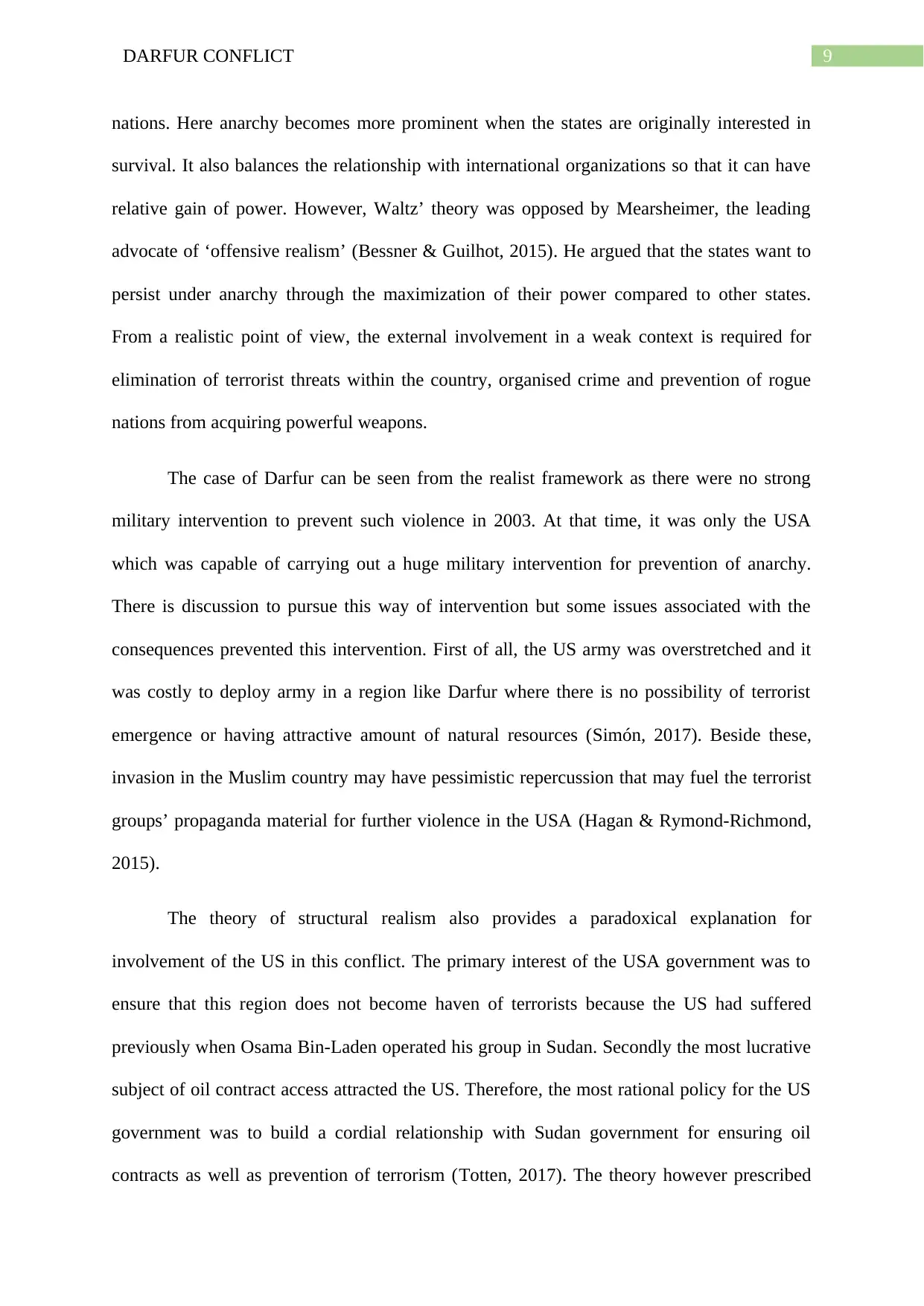
9DARFUR CONFLICT
nations. Here anarchy becomes more prominent when the states are originally interested in
survival. It also balances the relationship with international organizations so that it can have
relative gain of power. However, Waltz’ theory was opposed by Mearsheimer, the leading
advocate of ‘offensive realism’ (Bessner & Guilhot, 2015). He argued that the states want to
persist under anarchy through the maximization of their power compared to other states.
From a realistic point of view, the external involvement in a weak context is required for
elimination of terrorist threats within the country, organised crime and prevention of rogue
nations from acquiring powerful weapons.
The case of Darfur can be seen from the realist framework as there were no strong
military intervention to prevent such violence in 2003. At that time, it was only the USA
which was capable of carrying out a huge military intervention for prevention of anarchy.
There is discussion to pursue this way of intervention but some issues associated with the
consequences prevented this intervention. First of all, the US army was overstretched and it
was costly to deploy army in a region like Darfur where there is no possibility of terrorist
emergence or having attractive amount of natural resources (Simón, 2017). Beside these,
invasion in the Muslim country may have pessimistic repercussion that may fuel the terrorist
groups’ propaganda material for further violence in the USA (Hagan & Rymond-Richmond,
2015).
The theory of structural realism also provides a paradoxical explanation for
involvement of the US in this conflict. The primary interest of the USA government was to
ensure that this region does not become haven of terrorists because the US had suffered
previously when Osama Bin-Laden operated his group in Sudan. Secondly the most lucrative
subject of oil contract access attracted the US. Therefore, the most rational policy for the US
government was to build a cordial relationship with Sudan government for ensuring oil
contracts as well as prevention of terrorism (Totten, 2017). The theory however prescribed
nations. Here anarchy becomes more prominent when the states are originally interested in
survival. It also balances the relationship with international organizations so that it can have
relative gain of power. However, Waltz’ theory was opposed by Mearsheimer, the leading
advocate of ‘offensive realism’ (Bessner & Guilhot, 2015). He argued that the states want to
persist under anarchy through the maximization of their power compared to other states.
From a realistic point of view, the external involvement in a weak context is required for
elimination of terrorist threats within the country, organised crime and prevention of rogue
nations from acquiring powerful weapons.
The case of Darfur can be seen from the realist framework as there were no strong
military intervention to prevent such violence in 2003. At that time, it was only the USA
which was capable of carrying out a huge military intervention for prevention of anarchy.
There is discussion to pursue this way of intervention but some issues associated with the
consequences prevented this intervention. First of all, the US army was overstretched and it
was costly to deploy army in a region like Darfur where there is no possibility of terrorist
emergence or having attractive amount of natural resources (Simón, 2017). Beside these,
invasion in the Muslim country may have pessimistic repercussion that may fuel the terrorist
groups’ propaganda material for further violence in the USA (Hagan & Rymond-Richmond,
2015).
The theory of structural realism also provides a paradoxical explanation for
involvement of the US in this conflict. The primary interest of the USA government was to
ensure that this region does not become haven of terrorists because the US had suffered
previously when Osama Bin-Laden operated his group in Sudan. Secondly the most lucrative
subject of oil contract access attracted the US. Therefore, the most rational policy for the US
government was to build a cordial relationship with Sudan government for ensuring oil
contracts as well as prevention of terrorism (Totten, 2017). The theory however prescribed
Paraphrase This Document
Need a fresh take? Get an instant paraphrase of this document with our AI Paraphraser
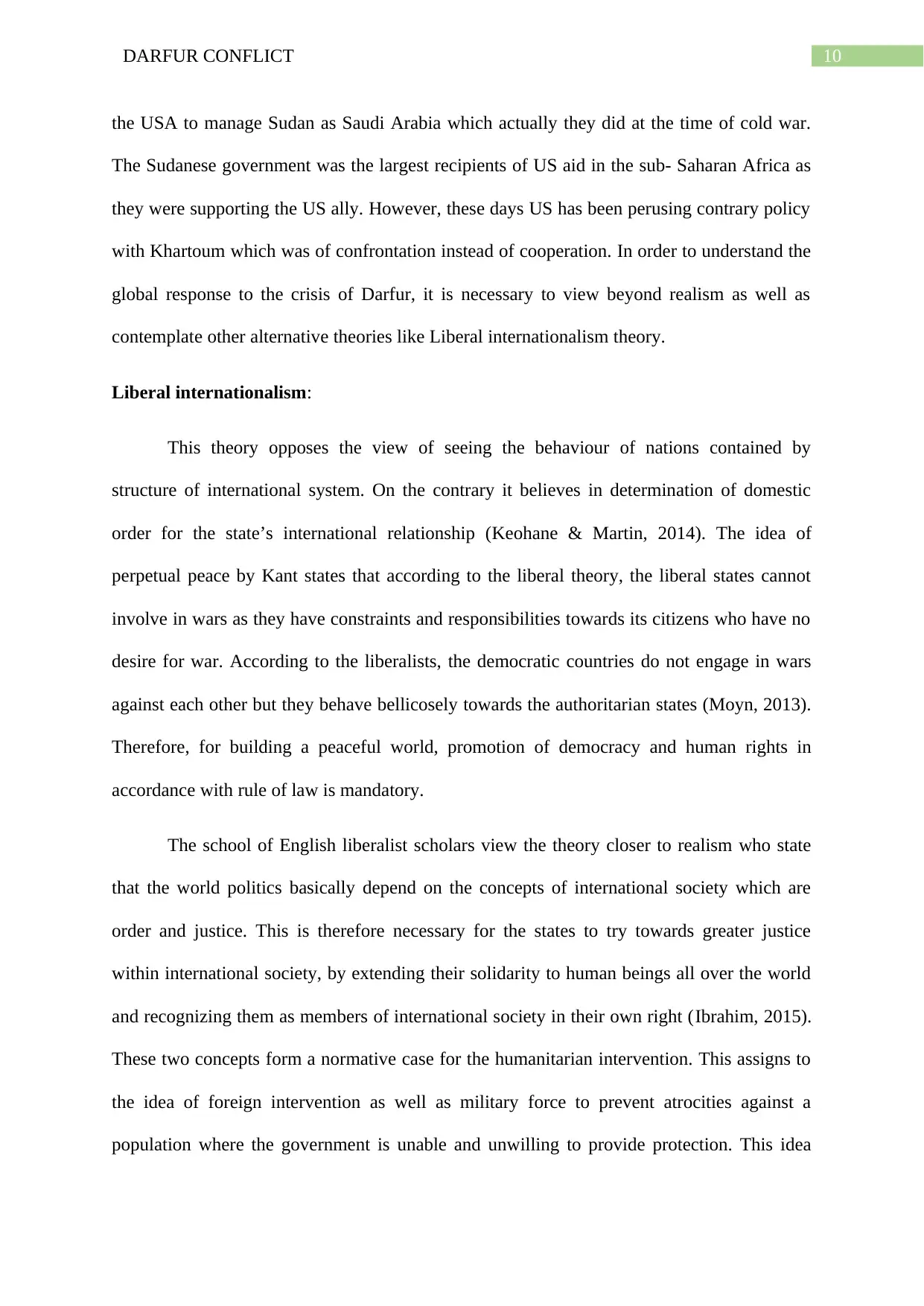
10DARFUR CONFLICT
the USA to manage Sudan as Saudi Arabia which actually they did at the time of cold war.
The Sudanese government was the largest recipients of US aid in the sub- Saharan Africa as
they were supporting the US ally. However, these days US has been perusing contrary policy
with Khartoum which was of confrontation instead of cooperation. In order to understand the
global response to the crisis of Darfur, it is necessary to view beyond realism as well as
contemplate other alternative theories like Liberal internationalism theory.
Liberal internationalism:
This theory opposes the view of seeing the behaviour of nations contained by
structure of international system. On the contrary it believes in determination of domestic
order for the state’s international relationship (Keohane & Martin, 2014). The idea of
perpetual peace by Kant states that according to the liberal theory, the liberal states cannot
involve in wars as they have constraints and responsibilities towards its citizens who have no
desire for war. According to the liberalists, the democratic countries do not engage in wars
against each other but they behave bellicosely towards the authoritarian states (Moyn, 2013).
Therefore, for building a peaceful world, promotion of democracy and human rights in
accordance with rule of law is mandatory.
The school of English liberalist scholars view the theory closer to realism who state
that the world politics basically depend on the concepts of international society which are
order and justice. This is therefore necessary for the states to try towards greater justice
within international society, by extending their solidarity to human beings all over the world
and recognizing them as members of international society in their own right (Ibrahim, 2015).
These two concepts form a normative case for the humanitarian intervention. This assigns to
the idea of foreign intervention as well as military force to prevent atrocities against a
population where the government is unable and unwilling to provide protection. This idea
the USA to manage Sudan as Saudi Arabia which actually they did at the time of cold war.
The Sudanese government was the largest recipients of US aid in the sub- Saharan Africa as
they were supporting the US ally. However, these days US has been perusing contrary policy
with Khartoum which was of confrontation instead of cooperation. In order to understand the
global response to the crisis of Darfur, it is necessary to view beyond realism as well as
contemplate other alternative theories like Liberal internationalism theory.
Liberal internationalism:
This theory opposes the view of seeing the behaviour of nations contained by
structure of international system. On the contrary it believes in determination of domestic
order for the state’s international relationship (Keohane & Martin, 2014). The idea of
perpetual peace by Kant states that according to the liberal theory, the liberal states cannot
involve in wars as they have constraints and responsibilities towards its citizens who have no
desire for war. According to the liberalists, the democratic countries do not engage in wars
against each other but they behave bellicosely towards the authoritarian states (Moyn, 2013).
Therefore, for building a peaceful world, promotion of democracy and human rights in
accordance with rule of law is mandatory.
The school of English liberalist scholars view the theory closer to realism who state
that the world politics basically depend on the concepts of international society which are
order and justice. This is therefore necessary for the states to try towards greater justice
within international society, by extending their solidarity to human beings all over the world
and recognizing them as members of international society in their own right (Ibrahim, 2015).
These two concepts form a normative case for the humanitarian intervention. This assigns to
the idea of foreign intervention as well as military force to prevent atrocities against a
population where the government is unable and unwilling to provide protection. This idea
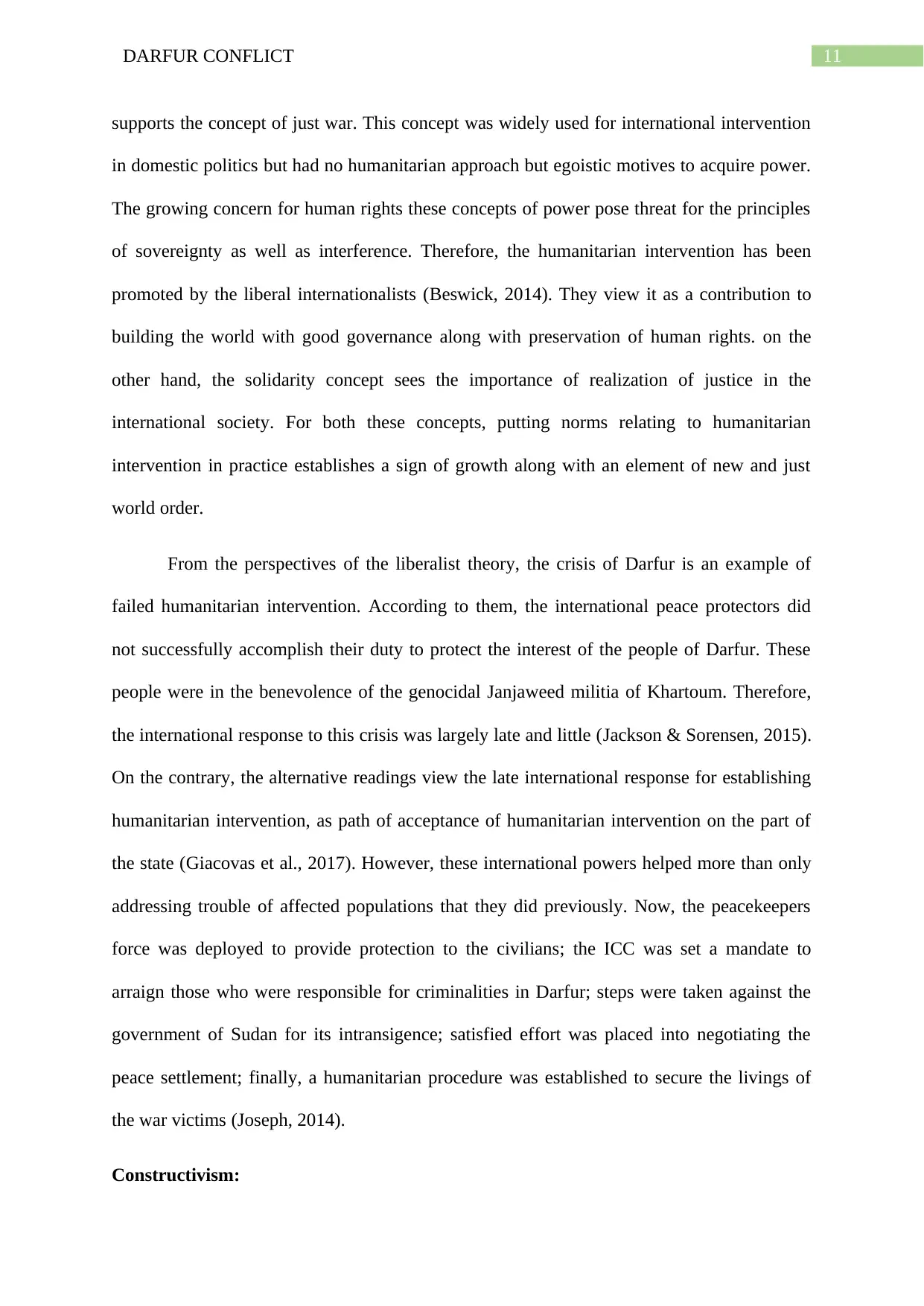
11DARFUR CONFLICT
supports the concept of just war. This concept was widely used for international intervention
in domestic politics but had no humanitarian approach but egoistic motives to acquire power.
The growing concern for human rights these concepts of power pose threat for the principles
of sovereignty as well as interference. Therefore, the humanitarian intervention has been
promoted by the liberal internationalists (Beswick, 2014). They view it as a contribution to
building the world with good governance along with preservation of human rights. on the
other hand, the solidarity concept sees the importance of realization of justice in the
international society. For both these concepts, putting norms relating to humanitarian
intervention in practice establishes a sign of growth along with an element of new and just
world order.
From the perspectives of the liberalist theory, the crisis of Darfur is an example of
failed humanitarian intervention. According to them, the international peace protectors did
not successfully accomplish their duty to protect the interest of the people of Darfur. These
people were in the benevolence of the genocidal Janjaweed militia of Khartoum. Therefore,
the international response to this crisis was largely late and little (Jackson & Sorensen, 2015).
On the contrary, the alternative readings view the late international response for establishing
humanitarian intervention, as path of acceptance of humanitarian intervention on the part of
the state (Giacovas et al., 2017). However, these international powers helped more than only
addressing trouble of affected populations that they did previously. Now, the peacekeepers
force was deployed to provide protection to the civilians; the ICC was set a mandate to
arraign those who were responsible for criminalities in Darfur; steps were taken against the
government of Sudan for its intransigence; satisfied effort was placed into negotiating the
peace settlement; finally, a humanitarian procedure was established to secure the livings of
the war victims (Joseph, 2014).
Constructivism:
supports the concept of just war. This concept was widely used for international intervention
in domestic politics but had no humanitarian approach but egoistic motives to acquire power.
The growing concern for human rights these concepts of power pose threat for the principles
of sovereignty as well as interference. Therefore, the humanitarian intervention has been
promoted by the liberal internationalists (Beswick, 2014). They view it as a contribution to
building the world with good governance along with preservation of human rights. on the
other hand, the solidarity concept sees the importance of realization of justice in the
international society. For both these concepts, putting norms relating to humanitarian
intervention in practice establishes a sign of growth along with an element of new and just
world order.
From the perspectives of the liberalist theory, the crisis of Darfur is an example of
failed humanitarian intervention. According to them, the international peace protectors did
not successfully accomplish their duty to protect the interest of the people of Darfur. These
people were in the benevolence of the genocidal Janjaweed militia of Khartoum. Therefore,
the international response to this crisis was largely late and little (Jackson & Sorensen, 2015).
On the contrary, the alternative readings view the late international response for establishing
humanitarian intervention, as path of acceptance of humanitarian intervention on the part of
the state (Giacovas et al., 2017). However, these international powers helped more than only
addressing trouble of affected populations that they did previously. Now, the peacekeepers
force was deployed to provide protection to the civilians; the ICC was set a mandate to
arraign those who were responsible for criminalities in Darfur; steps were taken against the
government of Sudan for its intransigence; satisfied effort was placed into negotiating the
peace settlement; finally, a humanitarian procedure was established to secure the livings of
the war victims (Joseph, 2014).
Constructivism:
⊘ This is a preview!⊘
Do you want full access?
Subscribe today to unlock all pages.

Trusted by 1+ million students worldwide
1 out of 19
Related Documents
Your All-in-One AI-Powered Toolkit for Academic Success.
+13062052269
info@desklib.com
Available 24*7 on WhatsApp / Email
![[object Object]](/_next/static/media/star-bottom.7253800d.svg)
Unlock your academic potential
Copyright © 2020–2025 A2Z Services. All Rights Reserved. Developed and managed by ZUCOL.





